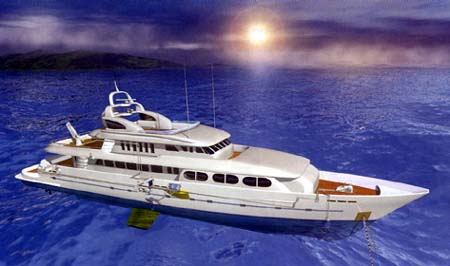By: REG POTTERTON
Timing and
fin speed are
critical
elements
for achieving
optimal OAS.

| STABILITY AT ANCHOR By: REG POTTERTON Timing and fin speed are critical elements for achieving optimal OAS. |

|
| Captain Peter Nord told YIM that while delivering a 160’
motor yacht retrofitted with a Quantum OAS control, he
had to shut down both engines in mid-Atlantic while the
chief engineer repaired a burned out thrust bearing on
the starboard prop shaft. “There was a good sized swell running,” Nord said, “so we used the bow thruster to keep her nose into the wind while the guys worked on the bearing. The chef was cursing me because of the rolling—it was uncomfortable for everybody. Then we turned on the On Anchor control and she came to attention like a dog on point! No pencils rolling around on the chart table, teacups staying where you left them. It was unbelievable.” In responding to a skipper seeking answers to specific questions about the efficiency of another Quantum OAS system, Chief Engineer Mark Scurrah (ex-M/Y Mi Giea) emailed back: “Yes, it does work, but my advice is to let the guys (the installers) have enough time to do the proper tests and calibrations…maintenance wise apart from possible initial leaks in hydraulic system, normal rotation for stabilizer maintenance…the response time is incredible!…there is little or no noise at anchor…yes, the boss was happy with the results.” Sea trials in the Mediterranean were carried out late last February aboard the 138’ Faribana in conditions described as moderate, with a steady swell. Tests included natural and forced roll, stability under way and stability while stopped. One observer reported that when the OAS mode was activated the vessel immediately stopped rolling and stayed at rest without any lateral movement on deck. He added that the power pack was extremely quiet and that there was no evidence of excessive noise inside the vessel either from the hydraulics or from the operation of the fins. |
Anyone considering installing an OAS control should
conduct a comprehensive feasibility study to determine
the vessel’s suitability, since OAS with high-speed fins is
not always effective for all yachts and may present a
dimensional challenge for semi-displacement hulls
because of underbody shape. Key determinants are the vessel’s natural roll period, limitations imposed by the area available for fin placement, and, on retrofits, the type and size of stabilizer hull units already in place. As indicated, the hull’s form and surface area—the envelope that determines OAS eligibility —must be able to accommodate the larger fins needed for optimal OAS performance. OAS fin systems may still be in their infancy but already the technology has entered a second and even more innovative phase. New microprocessor controls constantly monitor the fins’ response to wave motion and finetune themselves to produce optimal reactions according to the prevailing sea state. In other words, these systems have the capacity to learn and adapt, to store this knowledge in memory, consult it and act accordingly—all within less time than it takes to read this sentence. Go To Page 1 |
| NOTE: We have used the generic designation OAS (On Anchor Stability) to avoid repetition of the proprietary acronyms used by Naiad/KoopNautic (DATUM, Dynamic Adaptive Technology for Universal Motion control) and by Quantum (ARC, Adaptive Ride Control). | Magazine Article in a 270K PDF Adobe Acrobat file. |
| Broker John DeCaro |
| Fort Lauderdale, FL 33316 USA |
| Telephone: 954-671-0107 |
| info@buyexploreryachts.com |
| HOME | DESIGN | BROKERAGE | CREW | NEWS | F.A.Q.s | BIO | LINKS | EM@IL |